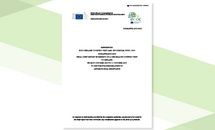Country visit to Ireland to discuss policies relating to antimicrobial resistance
ECDC and the European Commission's Directorate General for Health and Food Safety jointly carried out this country visit to Ireland from 7 to 11 October 2019. The visit was carried out following the invitation from the competent authorities to assist them in the development and implementation of their national strategy for tackling antimicrobial resistance (AMR) based on a 'One Health' approach.
Executive summary
Overall, the report concludes that there is a comprehensive inter-sectoral National Action Plan on AMR (iNAP) called for the period 2017-2020, which follows the structure of the WHO global action plan on AMR. There are clearly defined strategic objectives and related activities, timelines, responsibilities; however there are no quantitative targets or other indicators to enable measuring the plan's outcome.
In addition to an inter-departmental co-ordination committee, iNAP's implementation is overseen in the animal health and environmental sectors by an Animal Health Committee with their progress reports already published. On the human health side, implementation is led by the Health Service Executive which carry out the majority of actions and have developed an implementation plan over the life of iNAP. However, the implementation plan acknowledges that several of the actions are not achievable within the proposed timeframe and with the allocated funding.
One of the actions that is taken jointly by the human and animal health and environmental sectors is the publication of One Health Report on Antimicrobial Use & Antimicrobial Resistance. The first published report included the human and animal resistance data. The new report, which will be published shortly, will also include data on the antimicrobials and resistant bacteria found in the environment.
In the human health sector in Ireland, the antimicrobial consumption in the community is higher than the European average. For hospitals, the consumption is lower than the average. The total sales of antimicrobials in the veterinary sectors are moderate. However, over 60% of the sales concern oral antimicrobials, a significant proportion attributed to the pig sector, where they are routinely used around the weaning period and there is also a relatively high use of intramammary tubes for dairy cows because of the blanket use of antimicrobials at the end of lactation.
The competent authorities will shortly launch a database to collect the use of antimicrobials at farm level in pigs, and at a later stage, for the rest of the farmed animals. The authorities intend to use this database to benchmark farmers. It was suggested, the data could also be used to set up the targets for the next reiteration of iNAP.
The veterinary components of iNAP almost exclusively concentrate on farmed animals, as this sector is considered a priority. There are plans to include companion animals and horses in its next iteration. The iNAP initiatives linked directly to prudent use of antimicrobials are generally voluntary and many are stakeholder-driven. Despite this, there are clear cases of farmers not being receptive to the initiatives proposed by the stakeholders to reduce the use of antimicrobials, in particular in relation to the routine use of medicated feed in the pig producers. However, given that new EU legislation will become applicable in early 2022, there are no plans to strengthen the national regulatory framework on the prescription and use of antimicrobials. The Irish authorities are trying to find the right balance between compulsory and voluntary measures in order to maintain good cooperation with the vast majority of the stakeholders and have an influence in the antimicrobials prescribing patterns.
In the human health sector, multiple actions were undertaken to address the higher consumption of antimicrobials in the community, which aimed at sensitising general practitioners on the prudent use of antimicrobials, as well as the patients, who still seem to request antibiotics. In hospitals, antimicrobial stewardship teams were established; however, activities could not be conducted to optimal level due to either a lack of trained staff or time.
In terms of AMR surveillance, Ireland has high proportions of vancomycin-resistant Enterococci among Enterococcus faecium bloodstream infections and these are among the highest in Europe. Additional information on AMR comes from the reporting of some healthcare associated infections (HAIs) and the mandatory notification of cases. However, national data on AMR in the community and on AMR for pathogens not covered by European surveillance are not available. National reference laboratories exist for specific pathogens but there are no formal reference services for other pathogens of concern such as vancomycin-resistant Enterococci and Clostridioides difficile.
The CPE outbreak in 2017 and subsequent declaration of the National Public Health Emergency on CPE coincided with the launch of iNAP and required a lot of resources. On a positive side, it also resulted in raising awareness and in putting AMR on the agenda of all actors, focusing efforts for the control of AMR and HAIs. However, there is a risk that the focus on one specific pathogen with AMR might lead to a neglect of control of other pathogens with AMR and the prevention of HAIs in general. In addition, there is a need to ensure the sustainability of the CPE control activities once the emergency is declared over.
Ireland has participated in the point prevalence surveys of HAIs and there are regular audits of performance standards related to infection prevention and control (IPC). However, continuous outcome-based monitoring of HAIs is not in place and the IPC staffing levels of healthcare professionals with qualifications in IPC have improved but are still below the needs.
In relation to the environmental sector, the monitoring of Watch List substances under the Water Framework Directive is being carried out. The competent authorities are also working to address the issues with the quality of the water supply, waste water treatment and correct disposal of medicines. Additionally, the environmental and veterinary sectors have undertaken multiple actions on AMR surveillance, awareness raising and research.
In general, the commitment of actors, in all sectors and at all levels, to the control of AMR in Ireland is a positive example for other countries. There has been progress in AMR control on many levels and, while AMR will likely remain a significant challenge for the country, there are several achievements to build upon for future actions.
The report outlines various considerations which could be helpful in reviewing and implementing a national, One Health, AMR strategy.






